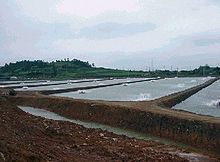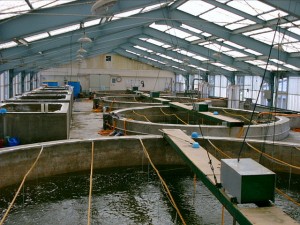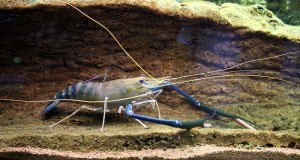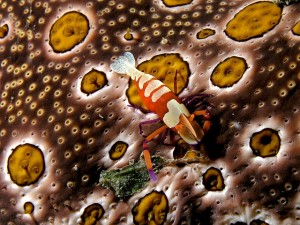Raising and producing freshwater shrimp or prawns in your own aquaculture fish farm can be a profitable business. Freshwater shrimp farming is suitable mostly in the warmer climate, and is similar to marine shrimp farming in many ways because they share many of the same characteristics and problems. Marine shrimp farming began in the 1970s and quickly became popular in the United States, Western Europe, and in some Asian countries. The total production of farmed shrimp reached over 1.6 million tons in 2003, which was valued at 9 billion dollars. The majority of the farmed shrimp, about 75% of the world’s farmed shrimp, are produced in Asia, particularly in Thailand and China. The other 25% is produced in the Latin American countries, such as Brazil, Mexico and Ecuador.
Shrimp farming has come a long way and has transformed into a global industry, from the small scale farms in Asia and Thailand. There are only a few species of shrimp that are farmed globally. One of the most popular species is the Macrobrachium rosenbergii, the Giant Malaysian Prawn, which is a freshwater prawn, native of South Asia.
Before you start your shrimp farm
Contact your local authorities first and obtain proper permits and business license for operating a commercial shrimp farm in your area. Most states will require you to purchase an aquaculture permit in order to operate a commercial freshwater shrimp farm. You can obtain a license from your state’s Department of Agriculture.
Starting your own freshwater shrimp business
The freshwater shrimp farming processes include growing out your juvenile shrimps into adults, and marketing them for profit. Research by Mississippi State University has demonstrated that this can be a profitable enterprise.
Shrimp production and the success of your business will largely depend on the quality of your pond. Usually freshwater shrimp farmers don’t get good results with freshly dug ponds because there is not enough supply of food available in the ponds. Shrimp mostly feed on insect larva and algae, which do not grow the first year after digging a pond. You must obtain your juveniles from a hatchery for the pond grow-out phase. You can easily find a commercial hatchery to purchase your juvenile shrimp from. You may find a shrimp hatchery in several states including Mississippi,Kentucky, Texas and Tennessee.
Site selection and pond design
Select a location to dig a pond specifically for raising freshwater shrimp. Although most farmers would dig a pond similar to a pond used for raising  channel catfish, you can also use large fish tanks and swimming pools. Water containers can also be used; however, a natural pond yields the best shrimp production for commercial farming. A good flow of fresh water is necessary for the shrimp. It is also important to supply them with enough oxygen. The soil needs to be in excellent condition for retaining water.
channel catfish, you can also use large fish tanks and swimming pools. Water containers can also be used; however, a natural pond yields the best shrimp production for commercial farming. A good flow of fresh water is necessary for the shrimp. It is also important to supply them with enough oxygen. The soil needs to be in excellent condition for retaining water.
The water you choose for your pond has to be clean, preferably well water of acceptable quality. Runoff from streams, rivers, and reservoirs can also be used, but it is very important to evaluate the quality of your water source before selecting a suitable site.
Make sure that you do not choose an area for freshwater shrimp farming which is subject to periodic flooding, or your shrimp will get away. Also make sure that there are no harmful chemicals present in the soil where you choose to dig your pond. Shrimp are sensitive to pesticides and chemical-based fertilizers used for crops. Avoid locations that are subject to nearby runoff water or drift which might contain agricultural spray or pesticides.
 Get samples of your soil from six different places, mix them together and let it dry. Send your soil sample to your state’s Extension Soil Testing Laboratory for soil testing. Determine the pH level of your soil. If your soil is too acidic, having a pH level of less than 6.5, you might need to add lime stone to your pond.
Get samples of your soil from six different places, mix them together and let it dry. Send your soil sample to your state’s Extension Soil Testing Laboratory for soil testing. Determine the pH level of your soil. If your soil is too acidic, having a pH level of less than 6.5, you might need to add lime stone to your pond.
After filling your pond with water, add natural organic fertilizers to ensure plenty of natural food for your shrimp. Shrimp need plenty of natural organisms to feed on. Get rid of unwanted weed from your pond. A liquid fertilizer gives you the best results.
Stocking the juvenile shrimp
 Before you stock your juvenile shrimp, check the pond water for insects and larva that might eat the young shrimp. Use an organic method for removing these insects and larva. If you’ve used water other than well water, make sure that there aren’t any other kinds of fish in the water, especially bass, green sunfish, and bluegills. If there are fish in the pond, get rid of them before stocking juvenile shrimp. These kinds of fish are predators for the shrimp. Gradually replace the water in which your juvenile shrimp were transported with the water from the pond. Make sure that the temperature difference of the water is within 6 degrees Fahrenheit. The pond water should be close to 68 degrees. Young juveniles are more susceptible to the cold than the adult shrimp. Stock shrimp at the rate of 12,000 – 16,000 per acre. Lower stocking density will increase the size of your shrimp, but decrease the total poundage of yield.
Before you stock your juvenile shrimp, check the pond water for insects and larva that might eat the young shrimp. Use an organic method for removing these insects and larva. If you’ve used water other than well water, make sure that there aren’t any other kinds of fish in the water, especially bass, green sunfish, and bluegills. If there are fish in the pond, get rid of them before stocking juvenile shrimp. These kinds of fish are predators for the shrimp. Gradually replace the water in which your juvenile shrimp were transported with the water from the pond. Make sure that the temperature difference of the water is within 6 degrees Fahrenheit. The pond water should be close to 68 degrees. Young juveniles are more susceptible to the cold than the adult shrimp. Stock shrimp at the rate of 12,000 – 16,000 per acre. Lower stocking density will increase the size of your shrimp, but decrease the total poundage of yield.
Feeding
At recommended density, your juvenile prawns stocked into grow-out ponds are able to find food themselves naturally from organisms growing in the pond. Start feeding when the shrimp exceed the size of 5.0 grams or greater. Commercial fish feed for channel cat fish is suitable for shrimp. Feeding will depend on the size of your fish. Refer to the table below.
Weight-dependent feeding rates for semi-intensive pond grow out of Macrobrachium
Table credit: The Fish Site |
|||||||||||
In our next blog, we will discuss in more detail about harvesting and selling your shrimp commercially for profit. We will also be giving you tips on water quality management, disease control, and controlling the chemical balance of your pond, periodically, so keep reading our blogs regularly. You may also call our office at (303) 495-3705 for more information.
Source: Worldwide Aquaculture




thank you for the information i just want to ask one q regarding the salt water ponds as the place i am living at is a vast of low salt water area that covers the surrounding. am i be able to farm there or not?